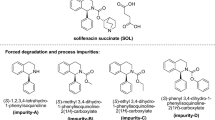Abstract
A validated, specific, stability-indicating reversed-phase liquid chromatographic method has been developed for quantitative analysis of gatifloxacin, its degradation products, and its process-related impurities in bulk samples and in pharmaceutical dosage forms. Forced degradation of gatifloxacin bulk sample was conducted in accordance with ICH guidelines. Acidic, basic, neutral, and oxidative hydrolysis, thermal stress, and photolytic degradation were used to assess the stability-indicating power of the method. Substantial degradation was observed during oxidative hydrolysis. No degradation was observed under the other stress conditions. The method was optimized using samples generated by forced degradation and sample solution spiked with impurities. Good resolution of the analyte peak from peaks corresponding to process-related impurities and degradation products was achieved on a C18 column by use of a simple linear mobile-phase gradient prepared from mixtures of acetonitrile and an aqueous solution of sodium dihydrogen orthophosphate dihydrate and triethylamine adjusted to pH 6.5 with orthophosphoric acid. Detection was performed at 240 nm. Limits of detection and quantification were established for gatifloxacin and its process-related impurities. When the stressed test solutions were assayed by comparison with gatifloxacin working standard the mass balance was always close to 99.3%, indicating the method was stability-indicating. Validation of the method was performed in accordance with ICH requirements. The method was found to be suitable for checking the quality of bulk samples of gatifloxacin at the time of batch release and also during storage.



Similar content being viewed by others
References
Gore J, Bryant Z, Stone MD, Nollmann M, Cozzarelli NR, Bustamante C (2006) Nature 439:100–104. doi:10.1038/nature04319
Arteseros AH, Barbosa J, Compañó R (2002) J Chromatogr A 945:1–24. doi:10.1016/S0021-9673(01)01505-9
Lorian V (ed) (1996) Antibiotics in laboratory medicine, 4th edn. Williams and Wilkins, Baltimore, pp 591–592
Samanidou VF, Demetriou CE, Papadoyannis IN (2003) Anal Bioanal Chem 375:623–629
Al-Dgither S, Alvi SN, Hammami MM (2006) J Pharm Biomed Anal 41:251–255. doi:10.1016/j.jpba.2005.09.026
Kothapalli L, Deshpande AD (2007) Indian J Pharm Sci 69:525–528
Jiang W, Guoa CC, Donga P, Chua ZJ, Wanga L, Jiang W (2008) Luminescence 23:7–13. DOI: 10.1002/bio.1008
ICH (1994) Text on validation of analytical procedures, Q2A (R1). International Conference on Harmonization, IFPMA, Geneva
US Food and Drug Administration (2001) Guidance for industry: analytical procedures and methods validation: chemistry, manufacturing, and controls documentation. Draft Guidance. US Food and Drug Administration
ICH (1996) Photo stability testing of new drug substances and products. Q1B, International Conference on Harmonization, IFPMA, Geneva
Shabir GA (2003) J Chromatogr A 987:57–66. doi:10.1016/S0021-9673(02)01536-4
Ribani M, Bottoli CBG, Collins CH, Jardim ISF, Melo LFC (2004) Quim Nova 27:771. doi:10.1590/S0100-40422004000500017
United States Pharmacopeia (2000) Validation of compendial methods, 24th edn, USP 24, Section 1225. U.S. Pharmacopeia, Rockville, MD, USA
Centre for Drug Evaluation and Research (1994) Validation of chromatographic methods; reviewer guidance, CMC 3, U.S.FDA(CDER), USA
Bakshi M, Singh S (2002) J Pharm Biomed Anal 28:1011–1040. doi:10.1016/S0731-7085(02)00047-X
ICH (2003) Stability testing of new drug substances and products Q1A (R2). International Conference on Harmonization, IFPMA, Geneva
Acknowledgments
The authors wish to thank the management of United States Pharmacopeia—India Private Limited group for supporting this work. We would also like to thank colleagues in the Separation Science Division of Analytical Research of United States Pharmacopeia-India Private Limited for their cooperation in carrying out this work.
Author information
Authors and Affiliations
Corresponding author
Rights and permissions
About this article
Cite this article
Lalitha Devi, M., Chandrasekhar, K.B. A Validated, Specific, Stability-Indicating RP-LC Method for Analysis of Gatifloxacin in the Presence of Degradation Products and Process-Related Impurities. Chroma 69, 985–992 (2009). https://doi.org/10.1365/s10337-009-0989-z
Received:
Revised:
Accepted:
Published:
Issue Date:
DOI: https://doi.org/10.1365/s10337-009-0989-z




